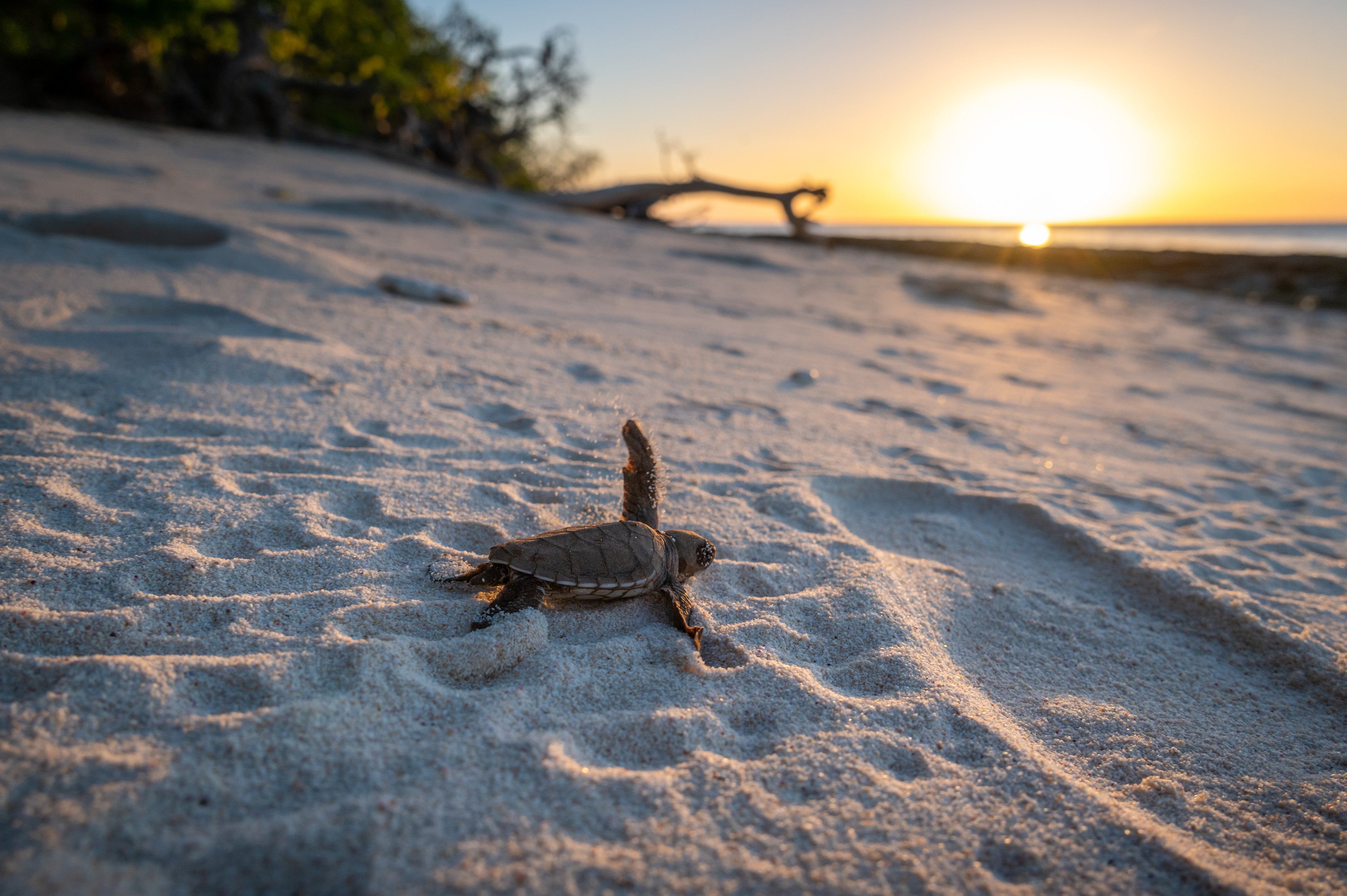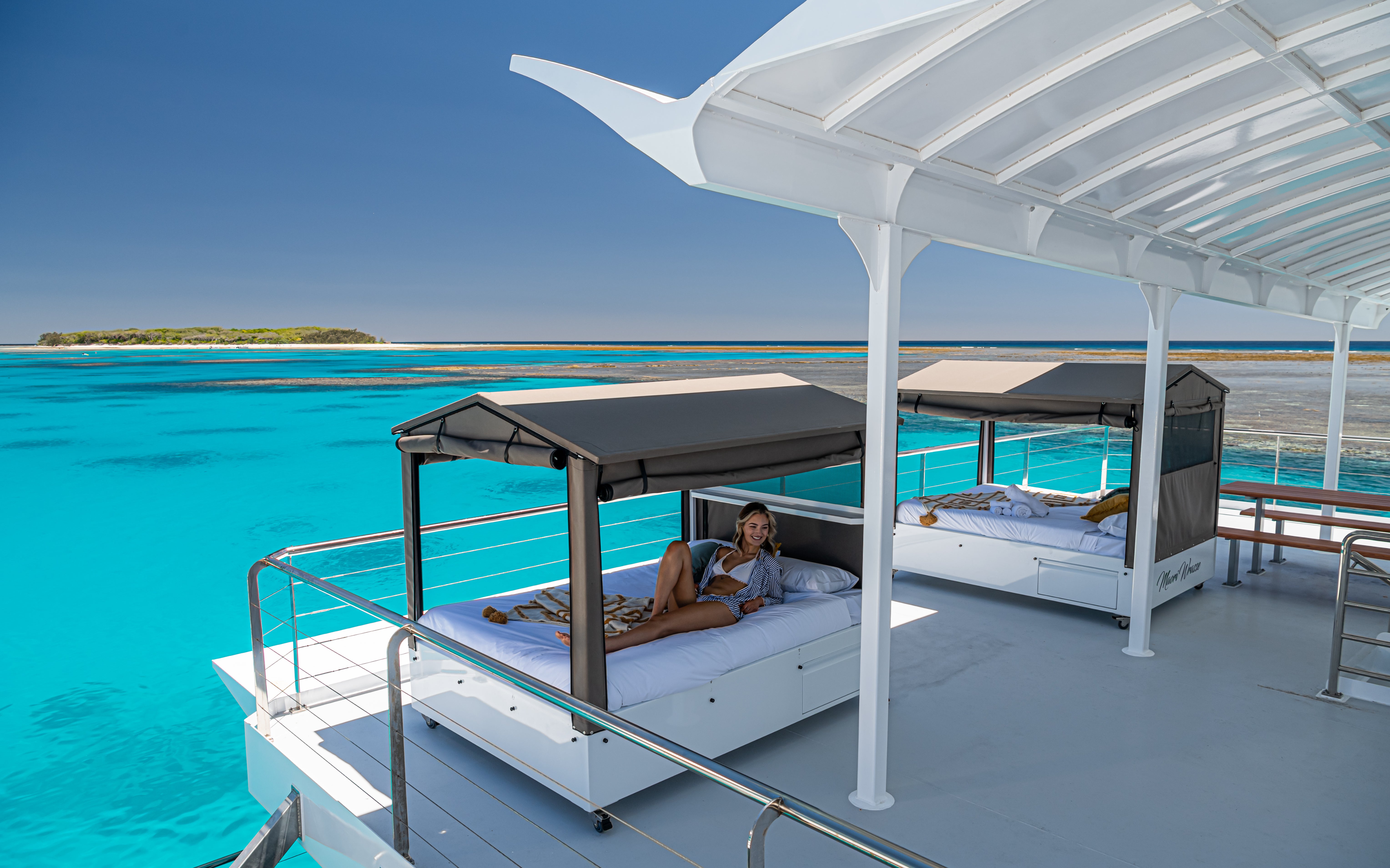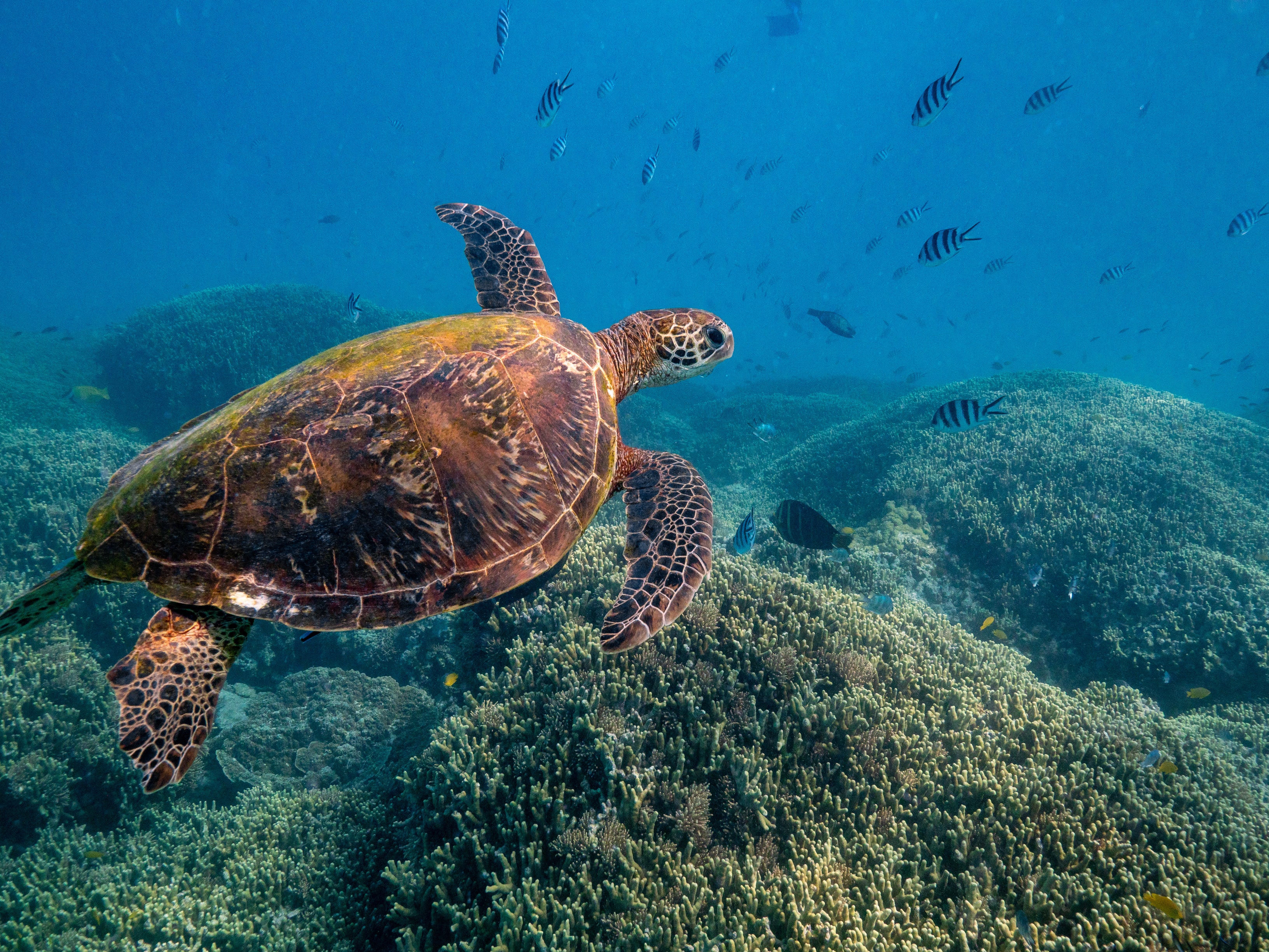Rest on your corals: How a floating hotel on the Great Barrier Reef is helping protect this delicate ecosystem
A stay aboard this new eco-pontoon on Lady Musgrave Island makes for the ultimate turtle-tourist bonding experience, writes Justin Meneguzzi

“Are we allowed to punch the birds if they try to eat the baby turtles?” asks one of my fellow island castaways, half-joking.
“Officially, no,” is the dry reply from Sanna Rigbye, a marine scientist who is leading us on a guided beach walk on Lady Musgrave Island in search of turtle hatchlings.
It’s nearly the end of March, late in the hatching season and the shore is pockmarked with mostly empty turtle nests, but Sanna has a knack for reading the signs that will lead us to an unhatched clutch buried beneath the sand. The best time to find the turtles is at sunset, when the hatchlings instinctively dig towards the cooling sand on the surface. The sinking sun is just beginning to set the sky ablaze when Sanna calls out – she’s found two nests.
Within moments, the beach is scattered with baby green turtles awkwardly flailing their tiny flippers in a race towards the water. We’re not allowed to touch or interfere with them, but our cameras certainly get a workout as we follow their adorable first journey and watch them zip off into the sea. Only a few successfully make their way to the Atlantic. The rest will make a delicious amuse-bouche for the half dozen eager reef sharks waiting in the shallows.

This is nature at its most pristine, infused with tranquillity and drama in equal measure, and on Lady Musgrave Island we have front row tickets in an empty theatre. The 14-hectare coral cay, found near the southernmost edge of Australia’s Great Barrier Reef, is just a two-hour boat ride from Bundaberg, yet it is one of the least frequented sections of the World Heritage-listed reef.
Around 350 clued-in day trippers cruise out to the island each day with Lady Musgrave Experience to float over the reef in a glass-bottom boat, learn to dive and snorkel to their heart’s content, but it’s only after they leave – a few hours before dusk – that the reef really comes alive.
I love the water. You go in there at 6am and it’s a party – all the turtles, all the sharks, all the fish, they’re everywhere!
That’s why I’m staying aboard the new Lady Musgrave HQ, a three-level eco-certified pontoon that was permanently moored in the island’s lagoon in mid-2021. The HQ, which serves as accommodation as well as a platform for snorkelling, diving and meals, is entirely powered by the reef thanks to solar panels, wind turbines and desalination pumps, with waste being collected and taken away by boat each day. Ordinarily up to 30 people can sleep aboard, but I realise as I’m waving goodbye to the day guests that there’s just five of us staying overnight. It’s enough for a private tour of the island in search of baby turtles.
It’s dark when we bid farewell to the turtles and return to the boat to learn our onboard chef, Rui Zanotto, has prepared a three-course dinner while we’ve been away, with a light-as-air meringue dessert that steals the show. I start to wonder if I could get used to being marooned on an island like this, so I ask the chef what it’s like. “God has blessed me with this job,” says Rui when he joins us after dinner. Originally from São Paulo, “a city with too many people where trains are crowded like tins of sardines,” Rui says he can’t imagine returning home after embracing the wide-open space on the reef. “I love the water. You go in there at 6am and it’s a party – all the turtles, all the sharks, all the fish, they’re everywhere!”

He's not wrong. At sunrise, I unzip the sides of my glamping bed and sip my morning coffee while watching an adult green turtle swim past. A few minutes later my snorkel is on and I’m floating over the reef, which has exploded with dawn activity exactly as Rui promised. Rainbow parrotfish are marauding the coral and a squad of translucent squid ripple through the water with their tiny fins. A white-tipped reef shark calmly goes about her business, weaving between wrinkly brain-like corals and enormous yellow plate corals, with schools of fish completely unperturbed by her presence. I spot a hawksbill turtle dozing on a coral bed while tiny fish clean his shell. Everywhere I look there is something new to see. The reef is a constantly shifting kaleidoscope of wildlife, light and colour that is never the same from moment to moment.
“I have dived and swum all around the world and the southern Great Barrier Reef is one of the healthiest reef ecosystems I’ve ever seen,” says Sanna. She’s tying a black and white secchi disk to a rope that she will then use to measure the clarity of the water. Her findings will be noted down as part of the Queensland government’s Eye on the Reef surveying program.
The reef is a constantly shifting kaleidoscope of wildlife, light and colour that is never the same from moment to moment
The Great Barrier Reef is bigger than Italy and scientists don’t have the resources to adequately monitor all of it on their own, which is why they turn to marine tourism operators like Lady Musgrave Experience to assist with research and monitoring. Once a week, Sanna swims out on the reef with guests to collect data – such as how clear the water is and how many keystone species are present – and then sends it to the Great Barrier Reef Marine Park Authority for analysis. Interested travellers, especially kids, can tag along with Sanna and pretend to be marine biologists for a day.
“I’ve realised that no amount of science is going to save the reef by itself. We need to be out there teaching children how to be more kind to the reef and our environment,” says Sanna.

Two young sisters join Sanna and I for the survey swim, their parents watching from the pontoon, and Sanna is visibly excited by the opportunity to teach them about the reef. Watching them point at all the marine life, their squeals of delight audible from under the water, I can’t help but wonder if I’m witnessing the precise moment a marine scientist is being made – a new generation of custodians to care for one of the world’s most beautiful ecosystems.
Travel essentials
Getting there
Lady Musgrave Experience departs from Bundaberg Port Marina daily, subject to weather. Bundaberg is a one-hour domestic flight from Brisbane with Qantas, or a four-hour drive from Brisbane.
Staying there
Travellers can stay overnight on Lady Musgrave Island’s lagoon at Lady Musgrave HQ. Accommodation options include eight reef view canopy beds on the upper deck, starting from €370pp per night twin share with minimum two-night stay, and bunk accommodation in the underwater observatory (minimum 10 people required and price on application). Rate includes all meals, linen, snorkelling equipment hire, guided island walking tour, glass bottom boat reef tour, and VIP transfers to the island, with the option to purchase additional snacks, drinks, and activities onboard. Guests share bathroom amenities, including gender-separated shower cubicles and changing rooms.
Visiting there
Kelly’s Beach Resort is an eco-certified resort just outside central Bundaberg featuring self-contained stand-alone villas for up to five people, starting from €57 per night per person for a two-bedroom villa (minimum two-night stay).
While in the region, learn about native macadamias before enjoying a guided tasting at Macadamias Australia (free entry), meet rescued farm animals at Splitters Farm (free entry but bookings recommended) or join a new generation of distillers at Kalki Moon for a tour and gin tasting (€7 per person).
Justin Meneguzzi travelled as a guest of Bundaberg Tourism.
Join our commenting forum
Join thought-provoking conversations, follow other Independent readers and see their replies
Comments
Bookmark popover
Removed from bookmarks